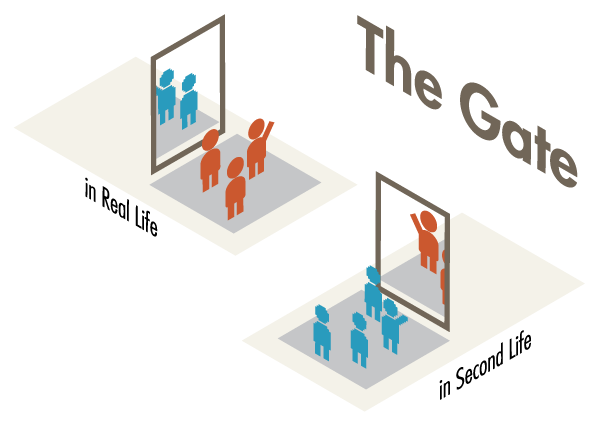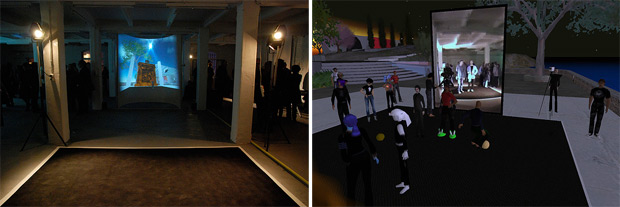Overview


The Gate is both an installation and a collaborative performance platform. The Gate connects the real life and the universe of Second Life (SL), it acts as a junction point, a door between the two worlds and two representation spaces. Basically, it is a simple window between both worlds where Real Life (RL) users and SL users see each other, can meet and interact. A view of the SL Gate is permanently projected in the real life venue; when an SL user with his/her avatar comes in front of The Gate in SL, it is visible in the real public space; when one arrives physically in front of the door in the public space, he/she becomes visible in SL and can interact with the SL users currently in front.

The result is a kind of happening where the virtuality of SL is transferred in the physicality of our public space and vice-versa; a stage for performance and interaction, something between a breakdance platform, an inter-dimensional portal and a peep show through parallel universes.
The Gate: Hole in Space reloaded
The Gate's most immediate cultural reference are the holes in space and time among the classic science fiction parallel universes. The Gate also revisits many 80's artistic telematics experiments of a full duplex presence between 2 worlds or 2 assistances, such as Hole in Space by Kit Galloway and Sherrie Rabinowitz, a memorable satellite performance which happened in 1980 between New-York and Los Angeles. It used two large screens set in two city squares, connected by satellite and respectively broadcasting what was happening in front of the other screen. The unannounced event produced an increasing interest from the first curiosity of passers-by to spectacular interactions between the two groups of spectators.

Symmetry of design
As for Hole in Space, we designed The Gate with the 2 spaces in front of the 2 screens as a dual stage for improvised performances based on communication and interaction between people and avatars. The symmetry of the two installations in the 2 worlds, Second Life and Real Life, is clearly emphasized (a black carpet delimiting the action area, shot by a camera set on the side of the vertical screen showing the other world). Beside delimiting the area, the carpet is useful to create a theater space accessible to everybody, welcoming as a break-dance stage. We want to avoid the fear for the stage and on the contrary promote improvisation, Second Life's soul: spontaneous theatricals.

Assymmetry of audiences
If The Gate is symmetric in the design of its dual spaces, it is rather assymetric when considering its 2 users assistances: one side is composed of real persons gathered at the same physical venue; the other is the Second Life assistance made of net users connected from all over the world, playing remotely through their avatars gathered at The Gate location in SL. The main sharing between them is being all there at the same time. This is a very different situation than 'Hole in Space' where the 2 groups where rather similar, i.e. an average sampling of passers-by population in New York and Los Angeles. Here, in The Gate first show at Brussels, the populations were very different. On one side, we had the specialised, very new and small Second Life avant-garde community of artists, performers and activists; on the real life side, at iMAL new venue, we could see the usual heterogeneous crowd coming for the inauguration of a new contemporary and new media art venue. The expectations and background references of these 2 users groups diverge a lot. For instance, most of the real life population did not know anything from Second Life apart from the usual buzz, but with a great ignorance of its current social, cultural, aesthetics and artistic codes. So for most of the public at iMAL, the SL scenes appearing on the screen featuring in 3d baroque decors provocative gestuals performed by avatars in colorful and excentric dressings were completely new, while they were considered as the usual banal and boring ones by some specialised SL art reviewers or critics. In this context, the behaviors of the 2 publics were rather disconnected : two worlds face to face, observing each other, or observing their very own internal behaviors with few interactions between them. As with many interactive installations, The Gate more sophisticated possibilities of interactions were discovered by those took the time to explore it afterwards far away from the crowd of the opening.

Conclusions: The Gate, reloaded
We expected and wanted the confrontation of these two very different audiences: it is indeed one of the challenges in the project. The magic of the experiment happened and was a public success, with a direct pleasure for both audiences from the real time confrontation of their two worlds, and a real pleasure for most RL users in contemplating and discovering the richness of a new populated world, SL. The Gate attracted a lot of participants and observers in SL with many articles announcing the project and reviewing it on the net. The Gate is probably one of the very first installation proposing a full duplex video streams between RL and SL. As such, it is a network platform for colloborative RL and SL users performances, its contents and main interests come from the users interacting on both sides. In this aspect, The Gate is very different from the synthetic performance of Eva and Franco Mattes at Ars Electronica, September 2007, where one prepared performance in SL is broacasted life to a large audience through a large video screen set up physically in a public space, in the same way an opera or theater play is broadcasted life in video.
The great divergences in SL and RL users profiles raise interesting issues about how The Gate can be improved as a rich interaction and collaborative performances platform and how its future context of deployment and announcement should be prepared. Indeed during the Brussels show, we changed the set up after the first day... The novelty of SL for most RL users was too high, and most RL users did not perceive that they were being seen by SL users, that they were existing in SL through their video images. The assymmetry of users population forced us to break the symmetry of the design by introducing a second video screen in the SL 3D world, a video screen seen by the SL synthetic camera (which defines what RL users see), a screen displaying in SL the video stream of RL users so that they could see their presence in SL.